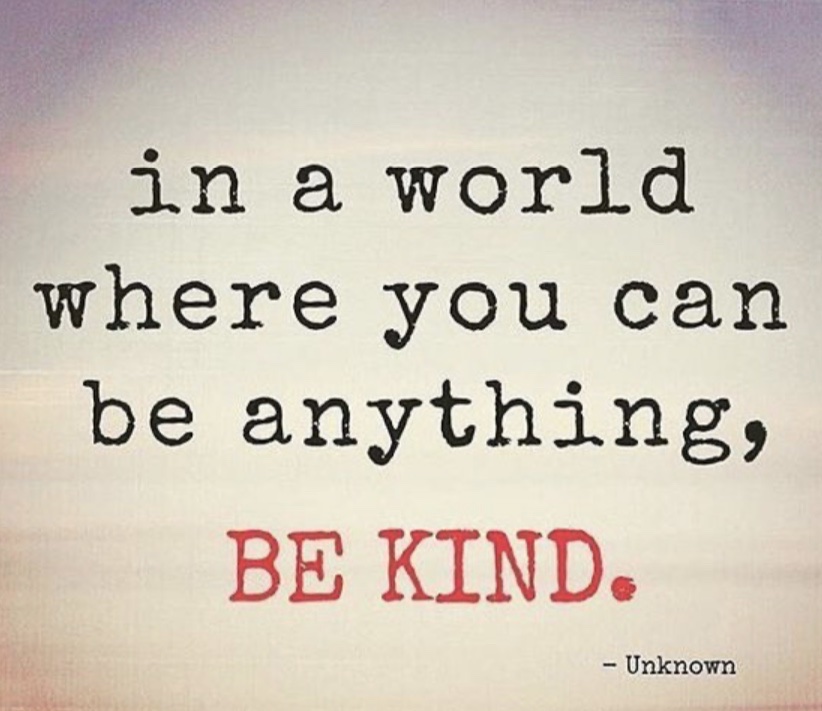
03 Dec Kind is not just a four-letter word
“A single act of kindness throws out roots in all directions, and the roots spring up and make new trees.” – Amelia Earhart
When I was a kid, I thought I knew what kindness meant. For me, it was about being nice to other people. It meant helping others, making them happy. It was about being good, not causing trouble or creating hassles.
Being kind was something I wanted to do as often as possible. In its simplicity, kindness was wonderful! But, as I got older, I realised my concept of kindness was not exactly right. I came to realise that “kind” is a much more interesting and complex word. As I’ve grown and gained more life experience, I now understand that the words “kind” and “kindness” aren’t always nice, soft or easy. They are words that are strong, can be hard and they hold a range of powerful messages.
Doing the nice thing, doing the good thing – this simple way of thinking about kindness doesn’t always apply. I’ve learnt that “kind” is relative to the context of what is happening, and the perspective of the doer, the receiver and the beholder. Kindness is a critical element of being human. Our society needs it to function effectively. We’re also now starting to see that kindness is a crucial part of being a leader.
Yet, while we may understand and accept this truth, finding and agreeing on the definition of kindness is more complicated. We need to, though, so we can truly appreciate its usefulness and application.
As I searched through dictionaries, both online and in old-world hard copies, I found the definitions of kind and kindness quite surprising. Words such as as empathy, consideration, kind-heartedness, nice and soft were associated with them. Hardly surprising, but it did make me think about what kindness means to me – and what kindness is not.
I began to identify situations where kindness is being used today, in ways that are useful and ways that are not. I think this difference can help us arrive at a deeper understanding of what kindness means, and how we can apply it in ways that serve our communities, businesses and the people we love.

What kindness Isn’t
“If you are kind, people may accuse you of ulterior motives. Be kind anyway.” – Mother Teresa
In the world of business, people often choose not to be kind to each other. Being kind can be considered a sign of weakness. That is a long way from the truth. The idols we once looked up to in business, even in broader society, are a key part of this belief. They push themselves and others, they pace-set and command. They’re the hustlers and the heartless, they claim to be fierce and tough. They don’t let kindness get in the way of their progress or their success. Their ideology is that kindness is not good business.
But is this true? Is conducting our business and personal lives this way the real path to success? Or is the more effective path one of kindness – real, useful and unflinching kindness.
I would offer the contrarian view, kindness is good for business. In 2017, Oxford University conducted a “Sincerely, Kindness” campaign, which encouraged participants to perform acts of kindness each day for seven days. The university’s researchers found that being kind increased participants’ levels of happiness and life satisfaction. It’s easy to see the parallel and the positive implications for workplace productivity, creativity and engagement.
Furthermore, when team members see their leaders as compassionate and kind, employees feel safe and their trust levels are elevated. They are more willing to share their ideas, feel connected to the company and team, and commit to the organisation for the long-term.
On the flipside, in workplaces where people are exposed to frequent rudeness And a lack of kindness, employees are less likely to help others and share their ideas. This creates a ripple effect that flows throughout the entire organisation, leading to mass dysfunction. Another challenge kindness faces is, there seems to be a lot of confusion around kind being another of those less useful four letter words.
Now I don’t mean those words, I mean words like nice, soft, weak and easy”. Words that suggest kindness is just a platitude.
It isn’t. Not even close.
It’s not nice, it’s not soft, it’s not weak and it isn’t always easy.
What do I mean…..
Kind and nice aren’t friends.
Nice mimics kind without strength, integrity, or being in service of a higher outcome.
Nice is not even a shadow of kind.
Kind and weak don’t talk.
Weak avoids difficulty and discomfort.
Kind steps into the space and holds it in service.
When weak appears, kind adds strength.
Kind and soft don’t dance. Soft slips around the truth and the real conversation that is needed.
Kind speaks the truth and gets to the heart of the matter.
It uses discernment to hold the conversations that need to be had.
Kind and easy don’t mix.
Easy means finding a way out. it seeks the lowest path, below the line.
Kindness means finding a way in and staying there until the work is done.

What Kind Is
Kind is an attitude. It’s a virtue, a choice.
Wikipedia defines kindness as:
“A behavior marked by ethical characteristics, a pleasant disposition in concern and consideration for others.”
This is a good place to start.
Let’s go a little deeper. For me, kindness goes beyond simple concern and consideration for others. It goes to a place of being in service to others and what they’re trying to achieve.
Kindness carries not just a pleasant disposition, but more powerfully, discernment. It knows when to speak and when to hold its voice, when to listen. Kind is comfortable with being uncomfortable. It knows its role can be challenging and demanding, yet it stays strong and holds the space.
Kind acts with integrity. It seeks to serve, not enslave; provides healing, not harm. It aims to resolve situations, even when the path ahead may be steep. In the words of Friedrich Wilhelm Nietzsche, kindness is one of “the most curative herbs and agents in human intercourse.”
There’s overwhelming selflessness and sense of service in kindness that cannot be understated. Aristotle defines kindness as “helpfulness towards someone in need, not in return for anything, nor for the advantage of the help of himself, but for that of the person helped.”
It’s this selflessness and sense of service that make our businesses, our communities, and ourselves stronger, more prosperous and more powerful.
Kindness Begins With You
“No act of kindness, no matter how small, is ever wasted.” – Aesop
Kindness starts at home. To bring kindness into the world, we must first be kind to those closest to us – and to ourselves.
Kind is about the choices we make each day. It’s living with integrity and knowing what our principles, foundational beliefs and ethics are in life. It’s also about treating ourselves in a way we would like to treat others.
Too often, we forget to serve ourselves. We try to help others so much that we spread ourselves too thin and put ourselves last. Our effectiveness in serving others is diminished, despite our best intentions.
A focus so far in this article has been that kindness is to be in service to others, but we must begin with ourselves. We can never be all we’re able to be for others unless we can be kind to ourselves first.
Where You Begin With Kindness
“Kindness in words creates confidence. Kindness in thinking creates profoundness. Kindness in giving creates love.” – Lao Tzu
There are many ways to practice being kind. They all begin with a willingness to open our eyes and notice the people around us. Who has a need, who is suffering, who requires support?
You don’t have to be Mother Teresa. Kindness can be as simple as a thoughtful word, a smile, opening a door, carrying a load, or giving someone a pat on the back.
There are many other ways we can apply kindness in the workplace and at home. We can celebrate achievements. Tell someone how important they are to us or our organisation. Give honest compliments and feedback. Deal with issues early and openly. Thank people for what they have done and how they have helped us. Set boundaries and clearly define the behaviours we expect from our team members to set them up for success.
On the other side, kindness is also choosing not to do certain things. Choosing not to gossip. Choosing not to shirk tasks or situations because they’re uncomfortable. Choosing not to call people out publicly on their errors. Choosing not to step back when people ask for assistance.
Kindness shouldn’t only appear when times are difficult. It should also appear when someone experiences success. Kindness fully embraces and celebrates other people’s achievements, regardless of self. Kindness is being openly happy for others when they have that win.
Kindness is also being truthful in a useful and gentle way to enable others to be more than they are, more than they were before the conversation. Offer feedback, be direct and open, being mindful that the aim of your truthfulness is to support, develop and enable the other person. These conversations aren’t always easy, they’re often the opposite, but they’re absolutely necessary for progress to be made.
I’m sure you can think of a swag more ways to be kind with your family, friends and team. As a human, one of the greatest gifts you can give to your team members , peers and your family is kindness. Kindness is a skill, and we should always seek ways to develop it in the way we execute and fulfil our leadership role, and all the other roles we have.
For me, kindness is one of the core competencies every leader and human should have. It’s critical to creating a better tomorrow for everyone. So, the next time you’re being kind, and someone offers you that old idiom, “you’re too kind,” stop. Smile at them and offer another perspective – that’s it’s impossible to ever be too kind.
Be kind, be well, be true, be you.
Andrew Deering
Organisational Capability Expert
Coach | Facilitator | Author of Creating the SHIFT
0459 806 046
ad@thedeering.com
Did you find this useful?
If you did, you might find my newsletter valuable. I share my reflections, thoughts and other things I hope are useful regularly via this medium.
If you’d like to subscribe, fill in this short form. I look forward to connecting there and continuing the conversation.
p.s.
If you’d like to keep the conversation going, there are a few other ways we can stay connected.
Get your copy of my book, Create the SHIFT
Click here to get a copy – or reach out via email.
Stay connected
I share my reflections, thoughts and other things I hope are useful on LinkedIn every day, along with a number of other platforms.
Lets talk
If you’re interested in working together, give me a call or send an email. I’d love to have a conversation with you.

